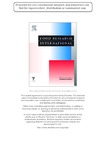Please use this identifier to cite or link to this item:
http://www.alice.cnptia.embrapa.br/alice/handle/doc/945832| Title: | Dynamics of the recovery of aroma volatile compounds during the concentration of cashew apple juice (Anacardium occidentale L.). |
| Authors: | SAMPAIO, K. de L.  BIASOTO, A. C. T.   MARQUES, E. J. N.   BATISTA, E. A. C.   SILVA, M. A. A. P. da   |
| Affiliation: | KARINA DE LEMOS SAMPAIO; ALINE TELLES BIASOTO MARQUES, CPATSA; EMANUEL JOSÉ NASCIMENTO MARQUES; EDUARDO AUGUSTO CALDAS BATISTA; MARIA APARECIDA A. PEREIRA DA SILVA. |
| Date Issued: | 2013 |
| Citation: | Food Research International, v. 51, p. 335-343, 2013. |
| Description: | The objective of this study was to identify and quantify the recovery of aroma volatiles during the concentration of cashew apple juice and propose kinetic models. Fresh juice was concentrated in a thermal-siphon type evaporator, operating in a closed system at 700 mm Hg. The water and volatiles evaporated during concentration were recovered by condensation, generating five condensates: the first was obtained during the concentration of the juice from 10.6 °Brix (fresh juice) to 12 °Brix, the second from 10.6 to 14 °Brix, the third from 10.6 to 19 °Brix, the fourth from 10.6 to 28 °Brix and the fifth from 10.6 to 40 °Brix. The volatiles in the headspaces of the condensates were vacuum stripped (70 mm Hg) to a Porapak Q? trap for 2 h, eluted with 300 μL of acetone, identified by GC?MS and quantified by external standardization. Trained judges rated the intensity of the cashew apple aroma perceived in the condensates using a 9 cm scale. The major classes of volatiles present in the condensates were esters (~90% of the total mass of volatiles), followed by aldehydes (6%) and alcohols (3%). In the first condensate the ester (580.3 μg L−1), aldehyde (39.3 μg L−1) and alcohol (23.5 μg L−1) concentrations were higher than in the remaining condensates, suggesting that a more efficient recovery of the volatiles important to the cashew apple aroma and flavor could be obtained when the beverage was concentrated from 10.6 to approximately 12 °Brix, namely, by condensing the first 23% of the water evaporated off from the juice. The power function was the kinetic model that best fitted the recovery of the esters, aldehydes and alcohols. |
| Thesagro: | Caju Aroma |
| Keywords: | Suco de caju Compostos voláteis Concentração Cashew apple |
| Type of Material: | Artigo de periódico |
| Access: | openAccess |
| Appears in Collections: | Artigo em periódico indexado (CPATSA)  |
Files in This Item:
| File | Description | Size | Format | |
|---|---|---|---|---|
| Aline2013.pdf | 526.93 kB | Adobe PDF |  View/Open |









